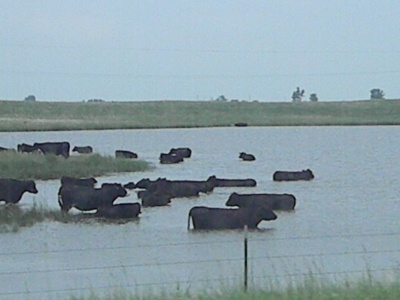
The high water levels on Lake Manitoba are forcing cattle producers out of business.
At 41-years-old, Joel Delaurier, who farms near Reykjavik, is a relatively young rancher, but he says his time in the cattle business is coming to an end.
"I just don't have any fight left in me. After coming out of BSE for all those years, I don't have any fight left in me to get through this. The easiest way that I can see is to sell the cows, sell the calves, and not have to worry about fighting for anything, not begging for handouts or anything," says Delaurier. "I'm not prepared to fight the flood and feed situation and promised government funding, so we've elected to just sell our cows."
The water on Delaurier's land has dropped approximately 16 inches since the crest, but it's still about 3 1/2 feet above normal. With two-thirds of his land still under water, he says he's nowhere close to having enough feed to get his animals through the winter.
"I have zero feed lined up. We managed to put up one thousand bales, but we fell four thousand bales short of what we need to feed the animals through the winter," he says, noting he can't afford to buy the required hay. "As far as renting pasture and the freight to get the cattle out, we have been promised we would see money for it, but I haven't seen one dime yet."
Delaurier says it will be several years before he will even consider rebuilding his herd.
"The land will be sour for at least three or four years. Even if they do drain the lake down by next year it will still be sour and we won't get any use from it. As well, we can't sell the land because it has zero dollar value because it's flooded," he says. "So what we plan on doing is working off-farm to pay the mortgage so we don't lose the land. In three years when we reclaim it from the flood, maybe at that time we'll get back into it."
Delaurier says his family is not alone.
"Everybody in our area is in the same situation. There's us and three neighbours in the exact same predicament," he says.
He says the province is not doing enough to lower the level of the lake.
"I'm not happy with the fact they're only giving us 2,500 cubic feet per second (outflow) than we already had...if that Portage Diversion can dump 35 thousand cubic feed per second alone, we should be able to expel what we're taking in," he says.
In the end, "if we can keep the family fed and pay the mortgage, we'll be fine," says Delaurier.















